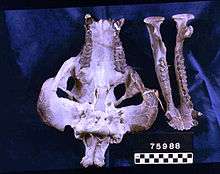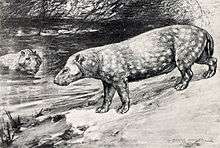Merycochoerus
| Merycochoerus Temporal range: Oligocene to Miocene 35–5 Ma | |
|---|---|
 | |
| Merycochoerus superbus skull | |
| Scientific classification | |
| Kingdom: | Animalia |
| Phylum: | Chordata |
| Clade: | Synapsida |
| Class: | Mammalia |
| Family: | †Merycoidodontidae |
| Genus: | †Merycochoerus Leidy (1858) |
| Species | |
|
see text | |
| Synonyms | |
| |
Merycochoerus is an extinct genus of terrestrial herbivore of the family Merycoidodontidae (oreodont), endemic to North America during the Late Oligocene to Early Miocene (28.4—16.3 mya) existing for approximately 12.1 million years.[2]
Morphology


A single specimen was examined by M. Mendoza for body mass and estimated to have a weight of 444.3 kg (979.5 lbs).[3]
Merycochoerus was a cud-chewing plant-eater with a long face, tusk-like canine teeth, heavy body, long tail, short feet, and four-toed hooves.. The 1 metre (3.3 ft) long animals are thought to have been amphibious, as members of the genus possessed an elongated, barrel-shaped body and short limbs that are typical adaptations found in semi-aquatic mammals.[4]
Taxonomy
Merycochoerus was named by Joseph Leidy in 1858. Cope in 1884 states the genus to be a nomen nudum in Leidy 1858 and Leidy 1869, but validated by Leidy 1873; however, Cope then accepts 1858 as the correct date for M. proprius. Its type is Merycochoerus proprius. It was assigned to Merycoidodontidae by Leidy (1858) and Lander (1998).[5] The genera Megoreodon, Paracotylops, Promerycochoerus, and Superdesmatochoerus were synonymized with Merycochoerus as junior synonyms by B. Lander in 1998.
Fossil distribution
Fossils are widespread through the western United States.
Species
- M. carrikeri (syn. Promerycochoerus thomsoni)
- M. chelydra (syn. Promerycochoerus barbouri)
- M. magnus
- M. matthewi
- M. pinensis
- M. proprius (type species)
- M. superbus (syn. M. fricki, M. leidyi, M. macrostegus, M. montanus, M. temporalis, Promerycochoerus grandis, P. hatcheri, P. hollandi, P. inflatus, P. latidens, P. loomisi, P. lulli, P. marshi, P. microcephalus)
- M. vantasselensis
Resources
- ↑ Palmer, D., ed. (1999). The Marshall Illustrated Encyclopedia of Dinosaurs and Prehistoric Animals. London: Marshall Editions. p. 270. ISBN 1-84028-152-9.
- ↑ PaleoBiology Database: Merycochoerus, basic info
- ↑ M. Mendoza, C. M. Janis, and P. Palmqvist. 2006. Estimating the body mass of extinct ungulates: a study on the use of multiple regression. Journal of Zoology
- ↑ Palmer, D., ed. (1999). The Marshall Illustrated Encyclopedia of Dinosaurs and Prehistoric Animals. London: Marshall Editions. p. 271. ISBN 1-84028-152-9.
- ↑ B. Lander. 1998. Oreodontoidea. In C. M. Janis, K. M. Scott, and L. L. Jacobs (eds.), Evolution of Tertiary mammals of North America 402-425
